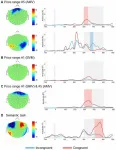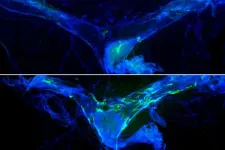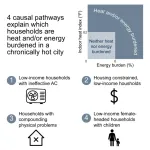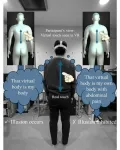(Press-News.org) Peking University, March 19, 2025: The research group led by Prof. Wang Chu from the College of Chemistry and Molecular Engineering at Peking University published a research article entitled “Quantitative Chemoproteomics Reveals Dopamine’s Protective Modification of Tau” in Nature Chemical Biology (DOI:10.1038/s41589-025-01849-9). Using a novel quantitative chemoproteomic strategy, the team uncovered a protective role of dopamine (DA) in regulating the function of the microtubule-associated protein Tau. This discovery deepens our understanding of dopamine’s physiological and pathological roles in the human brain.
Why it matters:
1. Dopamine, a critical neurotransmitter, is prone to oxidation, forming electrophilic products that react with proteins through a process termed dopamination.
2. While dopamine role in the nervous system is well-known, its functional impact on protein modifications, particularly Tau, has remained poorly understood.
The research:
1. The team developed a quantitative chemoproteomic strategy (DIA-ABPP) to globally measure dopamination at specific sites.
2. Using this approach, they identified and quantified over 6,000 dopamination sites, including two highly sensitive cysteines in Tau.
3. Biochemical validation revealed that dopamination of Tau prevents its amyloid fibrillation (a hallmark of neurodegenerative diseases) and promotes microtubule assembly, crucial for neuronal function.
4. Endogenous dopamination of Tau was also detected in mouse brains, confirming its physiological relevance.
Key findings and potentials:
1. Dopamine modifies Tau in a way that protects against harmful amyloid fibrillation and enhances microtubule assembly.
2. The study provides the first global portrait of dopamination, offering insights into dopamin’s physiological and pathological roles.
3. The findings have significantly contributed to the development of Tau-targeted therapies to treat neurodegenerative diseases such as Alzheimer’s.
*This article is featured in PKU News' "Why It Matters" series. More from this series.
Written by: Akaash Babar
Edited by: Zhang Jiang
Source: College of Chemistry and Molecular Engineering, Peking University
END
Unlocking dopamine’s hidden role: Protective modification of Tau revealed
2025-03-21
ELSE PRESS RELEASES FROM THIS DATE:
New drug therapy combination shows promise for advanced melanoma patients
2025-03-21
A federally funded research team led by Sheri Holmen, PhD, investigator at Huntsman Cancer Institute and professor in the Department of Surgery at the University of Utah (the U), is testing a new combination drug therapy that could both treat and prevent melanoma metastasis, or spreading from its original site, to the brain.
“Once melanoma has spread to the brain, it’s very hard to treat. Metastasis to the brain is one of the main causes of death from melanoma,” says Holmen. “We wanted to find a solution to an unmet clinical need for those patients who had no other treatment options ...
Nature’s warriors: How rice plants detect and defend against viral invaders
2025-03-21
Peking University, March 20, 2025: A groundbreaking study led by Li Yi, professor at the School of Life Sciences, was published in Nature on March 12, titled “Perception of viral infections and initiation of antiviral defence in rice”, uncovering a molecular mechanism by which rice cells perceive viral infections and initiate antiviral response, which significantly contributes to understanding of virus-host interactions for further disease resistance breeding.
Why it matters:
Viruses affecting rice, a staple food for more than half of the world population, pose ...
How the brain responds to prices: Scientists discover neural marker for price perception
2025-03-21
Russian scientists have discovered how the brain makes purchasing decisions. Using electroencephalography (EEG) and magnetoencephalography (MEG), researchers found that the brain responds almost instantly when a product's price deviates from expectations. This response engages brain regions involved in evaluating rewards and learning from past decisions. Thus, perceiving a product's value is not merely a conscious choice but also a function of automatic cognitive mechanisms. The results have been published in Frontiers in Human Neuroscience.
Every day, people are faced with prices of food, technology, and services. Sometimes, a product seems overpriced, ...
Boosting brain’s waste removal system improves memory in old mice
2025-03-21
As aging bodies decline, the brain loses the ability to cleanse itself of waste, a scenario that scientists think could be contributing to neurodegenerative conditions such as Alzheimer’s disease and Parkinson’s disease, among others. Now, researchers at Washington University School of Medicine in St. Louis report they have found a way around that problem by targeting the network of vessels that drain waste from the brain. Rejuvenating those vessels, they have shown, improves memory in old mice.
The study, published online March 21 in the journal Cell, lays the groundwork to develop therapies for age-related cognitive decline that overcome ...
New study sheds light on risks from residential heat and energy burdens in Miami
2025-03-21
A new study on indoor extreme heat connects these two burdens to reveal how the co-occurrence of escalating energy bills and dangerously hot homes in Miami-Dade County exacerbates health and well-being risks for vulnerable households across months of the year.
“Our findings help us understand which types of households are struggling with high indoor heat and high energy bills in a place like Miami, which is hot for many months of the year,” said Lynée Turek-Hankins, the lead author of the study that was conducted during her doctoral studies at the University of Miami Rosenstiel School of Marine, Atmospheric, and Earth Science and the Abess Center for Ecosystem ...
Racial and ethnic inequalities in actual vs nearest delivery hospitals
2025-03-21
About The Study: This cohort study found that American Indian and Black individuals delivered at lower-quality hospitals than white individuals. The disparity in care between Black and white birthing individuals would have been reduced if individuals had delivered at their nearest hospital.
Corresponding Author: To contact the corresponding author, Nansi S. Boghossian, PhD, email nboghoss@email.sc.edu.
To access the embargoed study: Visit our For The Media website at this link https://media.jamanetwork.com/
(doi:10.1001/jamanetworkopen.2025.1404)
Editor’s ...
State earned income tax credits and firearm suicides
2025-03-21
About The Study: In this cohort study, the presence and generosity of state refundable earned income tax credits were associated with a decrease in firearm suicide rates, supporting the growing body of literature highlighting the importance of antipoverty policies for reducing firearm suicide.
Corresponding Author: To contact the corresponding author, Nicole Asa, MPH, email nasa3@uw.edu.
To access the embargoed study: Visit our For The Media website at this link https://media.jamanetwork.com/
(doi:10.1001/jamanetworkopen.2025.1398)
Editor’s Note: Please see the article for additional information, ...
VR study reveals how pain and fear weaken sense of body ownership
2025-03-21
A study from Hiroshima University found that when people were told to imagine their virtual bodies in pain, their brains resisted the illusion of ownership. Their findings could provide insights into why some people may struggle with feeling connected to their own bodies, particularly in contexts involving depersonalization or negative physical states.
The sense of body ownership—the feeling that our body belongs to us—is crucial in distinguishing ourselves from objects and responding to threats. Researchers study it using techniques like the rubber hand illusion (RHI) and full-body illusion (FBI), in which an individual is somehow ...
Quantum leap: Graphene unlocks orbital hybridization
2025-03-21
Peking University, March 19, 2025: A research team led by Professor Sun Qing-Feng in colloboration with Professor He Lin’s research group from Beijing Normal University has achieved orbital hybridization in graphene-based artificial atoms for the first time. Their findings, entitled “Orbital hybridization in graphene-based artificial atoms” was published in Nature (DOI: 10.1038/s41586-025-08620-z). This work marks a significant milestone in the field of quantum physics and materials science, bridging the gap between artificial and real atomic behaviors.
Why it matters:
1. Quantum dots, often called artificial atoms, can mimic atomic orbitals but have not yet ...
How black holes could nurture life
2025-03-21
At the center of most large galaxies, including our own Milky Way, sits a supermassive black hole. Interstellar gas periodically falls into the orbit of these bottomless pits, switching the black hole into active galactic nucleus (AGN)-mode, blasting high-energy radiation across the galaxy.
It's not an environment you'd expect a plant or animal to thrive in. But in a surprising new study in the Astrophysical Journal, researchers at Dartmouth and the University of Exeter show that AGN radiation can have a paradoxically nurturing effect on life. Rather ...




